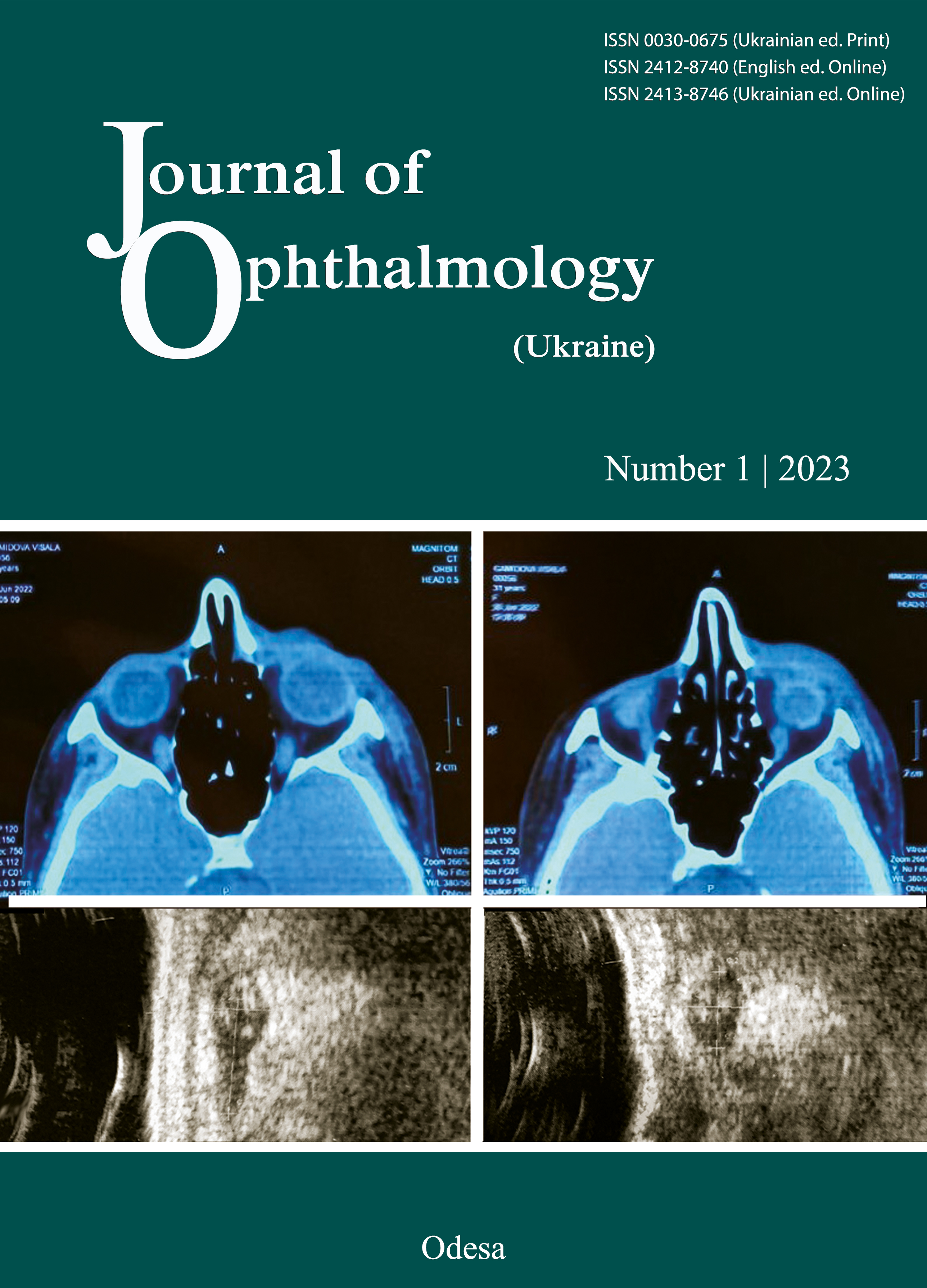Хірургічна тактика лікування краніофаціальних пухлин, їх інтра-, екстракраніального та інтраорбітального поширення
DOI:
https://doi.org/10.31288/oftalmolzh202314651Ключові слова:
краніофаціальні пухлини, трансбазальний доступ, субкраніальний доступАнотація
Актуальність. Хірургічне лікування краніофаціальних пухлин з інтра-, екстракраніальним та інтраорбітальним поширенням потребує залучення декількох окремих хірургічних бригад: нейрохірургічної, ЛОР-хірургічної та офтальмологічної (для проведення окремого доступу). Оскільки краніофаціальні доступи передбачають формування декількох окремих «хірургічних полів», зростає тривалість самої операції. Традиційний трансбазальний доступ Derome, як менш травматичний, порівняно із передньою краніофаціальною резекцією, не потребує проведення додаткових лицевих розрізів. А його модифікація – субкраніальний доступ може бути альтернативою, як малоінвазивний варіант.
Мета. Вивчити ефективність хірургічного лікування краніофаціальних пухлин з інтра-, екстракраніальним та інтраорбітальним поширенням.
Матеріал і методи. Було проаналізовано результати хірургічного лікування 88 хворих з краніофаціальними пухлинами, з них у 62 хворих були злоякісні, а у 26 – доброякісні пухлини. У 12 (14%) випадках виконано трансбазальний доступ Derome; в інших 76 (86 %) – його модифікація – субкраніальний доступ (через лобну пазуху).
Результати. Тотального (чисті краї рани) видалення пухлини було досягнуто у 81 випадку – 92% (трансбазальний доступ Derome – 11 (92%) випадків; субкраніальний доступ – 70 (92%) випадків). У 7 (8 %) випадках із злоякісними пухлинами було виконане субтотальне видалення пухлини (при трансбазальному доступі Derome – 1 (8%) випадок, субкраніальному – 6 (8 %) випадків). Тривалість операції при трансбазальному доступі Derome (12 випадків) в середньому становила 372 ± 48 хвилин. При модифікованому субкраніальному доступі (76 випадків) тривалість операції становила в середньому 291 ± 24 хвилин.
Заключення. Трансбазальні доступи дають змогу видаляти пухлини з одночасним інтра-, екстракраніальним, а також інтраорбітальним ростом. Мінімізація трансбазального доступу Derome – субкраніальний доступ (через лобну пазуху) є простішим у технічному виконанні, швидшим, менш травматичним, при необхідності може бути латералізований та в радикальності видалення досягає такого ж результату, як при трансбазальному доступі Derome.
Посилання
Aftahy AK, Barz M, Wagner A, et al. The transbasal approach to the anterior skull base: surgical outcome of a single-centre case series. Sci Rep. 2020;10(1):22444. https://doi.org/10.1038/s41598-020-80255-8
Ciechomski J, Aufgang R, Villanueva L, Demarchi V. Subcranial approach in pediatric craniofacial surgery. Craniomaxillofac Trauma Reconstr. 2010;3(4):231-236. https://doi.org/10.1055/s-0030-1268521
Derome PJ. The transbasal approach to tumors invading the base of the skull. In: Schmidek HH, Sweet WH, eds. Operative Neurosurgical Techniques: Indications, Methods, and Results. Boston: Grune & Stratton; 1982:357-379.
Feiz-Erfan I, Spetzler RF, Horn EM, et al. Proposed classification for the transbasal approach and its modifications. Skull Base. 2008;18(1):29-47. https://doi.org/10.1055/s-2007-994292
Fliss DM, Abergel A, Cavel O, Margalit N, Gil Z. Combined subcranial approaches for excision of complex anterior skull base tumors. Arch Otolaryngol Head Neck Surg. 2007;133(9): 888-896. https://doi.org/10.1001/archotol.133.9.888
Fliss DM, Gil Z. The Subcranial Approach to the Anterior Skull Base. Atlas of Surgical Approaches to Paranasal Sinuses and the Skull Base. 2016: 139-152. https://doi.org/10.1007/978-3-662-48632-0_5
Fliss DM, Zucker G, Amir A, Gatot A. The combined subcranial and midfacial degloving technique for tumor resection: report of three cases. J Oral Maxillofac Surg. 2000;58(1): 106-110. https://doi.org/10.1016/S0278-2391(00)80027-0
Gil Z, Margalit N, Fliss DM. Open Surgical Approaches to the Anterior Skull Base and Paranasal Sinuses. In: Gil Z., Fliss D. (eds) Tumors of the Skull Base and Paranasal Sinuses. Head and Neck Cancer Clinics. Springer, 2012. New Delhi. https://doi.org/10.1007/978-81-322-2583-6
Gil Z, Spektor S, Abergel A, Cohen JT, Khafif A, Shlomi B, et al. [The subcranial approach for tumors involving the anterior skull base]. Harefuah. 2003 Jun; 142(6): 416-20, 487, 486.
Jittapiromsak P, Wu A, Deshmukh P, et al. Comparative analysis of extensions of transbasal approaches: effect on access to midline and paramedian structures. Skull Base. 2009;19(6):387-399. https://doi.org/10.1055/s-0029-1224773
Joseph ST, Thankappan K, Buggaveeti R, Iyer S. Pneumosinus Dilatans Helping Subcranial Resection in a Patient with Advanced Ethmoid Malignancy. Craniomaxillofac Trauma Reconstr. 2015;8(3):218-220. https://doi.org/10.1055/s-0034-1393736
Kim YS, Moon KS, Kim GW, et al. Role of Craniofacial Resection for Malignant Tumors Involving the Anterior Skull Base: Surgical Experience in a Single Institution. Brain Tumor Res Treat. 2015;3(2):81-88. https://doi.org/10.14791/btrt.2015.3.2.81
Laedrach K, Remonda L, Lukes A, Schroth G, Raveh J. Evaluation of the Contribution of CAS in Combination with the Subcranial/Subfrontal Approach in Anterior Skull Base Surgery. Skull Base. 2001;11(1): 59-76. https://doi.org/10.1055/s-2001-12785
Liu JK, Decker D, Schaefer SD, Moscatello AL, Orlandi RR, Weiss MH, et al. Zones of Approach for Craniofacial Resection: Minimizing Facial Incisions for Resection of Anterior Cranial Base and Paranasal Sinus Tumors. Neurosurgery. 2003; 53(5): 1126-1137. https://doi.org/10.1227/01.NEU.0000088802.58956.5A
Plinkert PK, Zenner HP. Transfazialer Zugang, kraniofaziale Resektion und Midfacial Degloving bei der Chirurgie bösartiger Tumoren der vorderen Schädelbasis und der angrenzenden Nasennebenhöhlen [Transfacial approach, craniofacial resection and midfacial degloving in surgery of malignant tumors of the anterior cranial base and adjacent paranasal sinuses]. HNO. 1996;44(4): 192-200.
Raso JL, Gusmão S. Transbasal approach to skull base tumors: evaluation and proposal of classification. Surg Neurol. 2006;65 Suppl 1:S1:33-1:38. https://doi.org/10.1016/j.surneu.2005.11.037
Ross DA, Marentette LJ, Moore CE, Switz KL. Craniofacial resection: decreased complication rate with a modified subcranial approach. Skull Base Surg. 1999;9(2): 95-100. https://doi.org/10.1055/s-2008-1058155
Wigand ME, Iro H, Bozzato A. Transcranial combined neurorhinosurgical approach to the paranasal sinuses for anterior skull base malignancies. Skull Base. 2009;19(2): 151-158. https://doi.org/10.1055/s-0028-1096200
Sakata K, Maeda A, Rikimaru H, Ono T, Koga N, Takeshige N, et al. Advantage of Extended Craniofacial Resection for Advanced Malignant Tumors of the Nasal Cavity and Paranasal Sinuses: Long-Term Outcome and Surgical Management. World Neurosurgery. 2016; 89: 240-254. https://doi.org/10.1016/j.wneu.2016.02.019
Gil Z, Patel SG, Bilsky M. et al. Complications after craniofacial resection for malignant tumors: are complication trends changing. Otolaryngol. Head Neck Surg. 2009; 140 (2): 218-223. https://doi.org/10.1016/j.otohns.2008.10.042
##submission.downloads##
Опубліковано
Як цитувати
Номер
Розділ
Ліцензія
Авторське право (c) 2023 Паламар О.І., Гук А.П., Лукач Е.В., Оконський Д.І., Тесленко Д.С., Давиденко Б.О.

Ця робота ліцензується відповідно до Creative Commons Attribution 4.0 International License.
Ця робота ліцензується відповідно до ліцензії Creative Commons Attribution 4.0 International (CC BY). Ця ліцензія дозволяє повторно використовувати, поширювати, переробляти, адаптувати та будувати на основі матеріалу на будь-якому носії або в будь-якому форматі за умови обов'язкового посилання на авторів робіт і первинну публікацію у цьому журналі. Ліцензія дозволяє комерційне використання.
ПОЛОЖЕННЯ ПРО АВТОРСЬКІ ПРАВА
Автори, які подають матеріали до цього журналу, погоджуються з наступними положеннями:
- Автори отримують право на авторство своєї роботи одразу після її публікації та назавжди зберігають це право за собою без жодних обмежень.
- Дата початку дії авторського права на статтю відповідає даті публікації випуску, до якого вона включена.
ПОЛІТИКА ДЕПОНУВАННЯ
- Редакція журналу заохочує розміщення авторами рукопису статті в мережі Інтернет (наприклад, у сховищах установ або на особистих веб-сайтах), оскільки це сприяє виникненню продуктивної наукової дискусії та позитивно позначається на оперативності і динаміці цитування.
- Автори мають право укладати самостійні додаткові угоди щодо неексклюзивного розповсюдження статті у тому вигляді, в якому вона була опублікована цим журналом за умови збереження посилання на первинну публікацію у цьому журналі.
- Дозволяється самоархівування постпринтів (версій рукописів, схвалених до друку в процесі рецензування) під час їх редакційного опрацювання або опублікованих видавцем PDF-версій.
- Самоархівування препринтів (версій рукописів до рецензування) не дозволяється.












